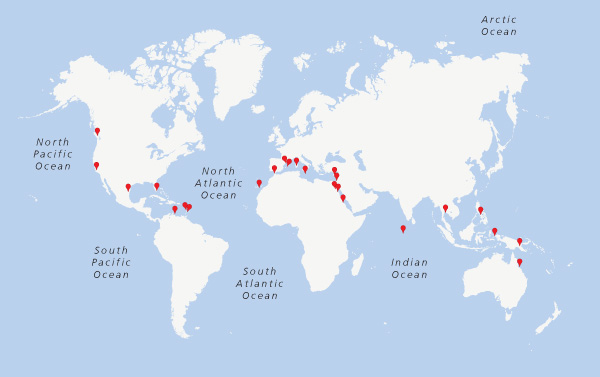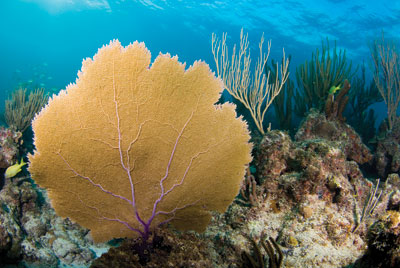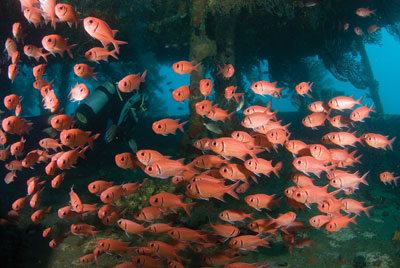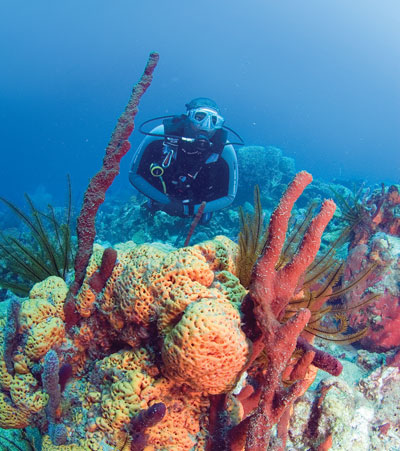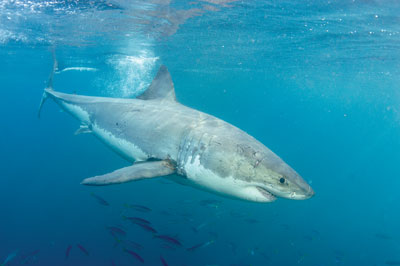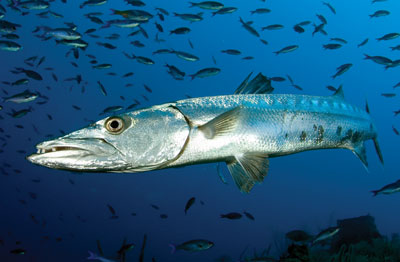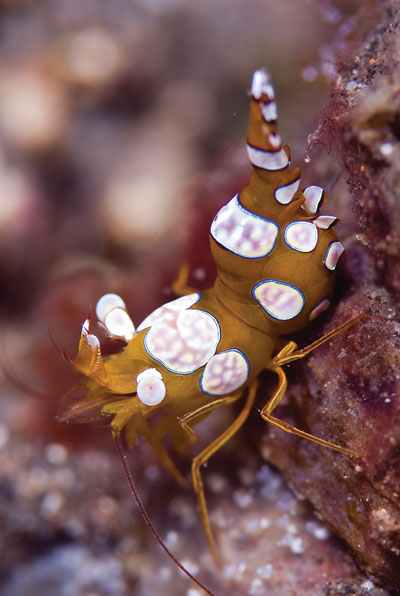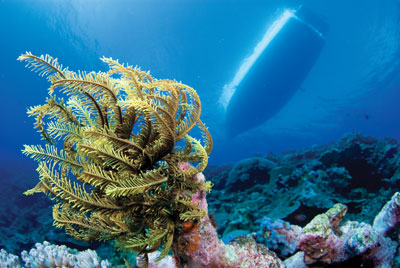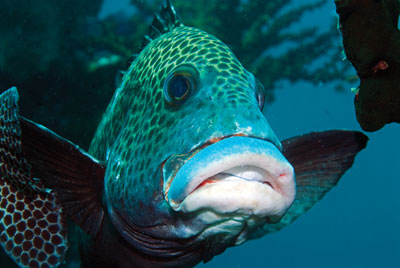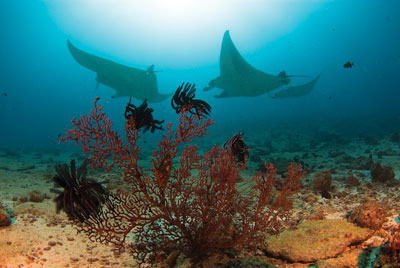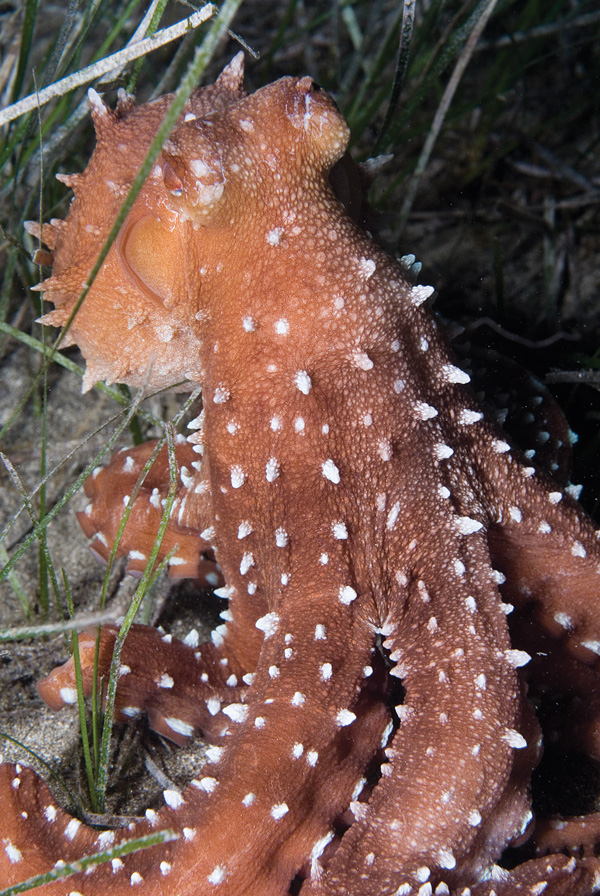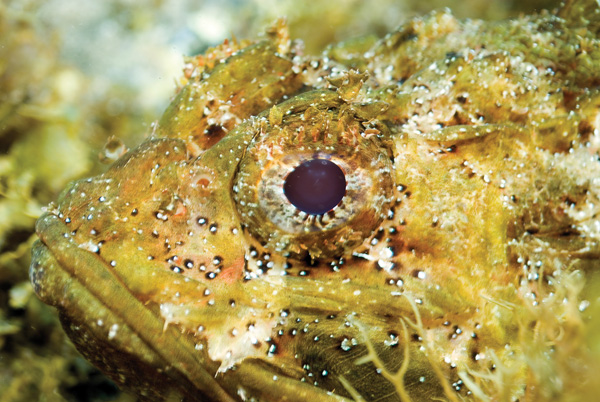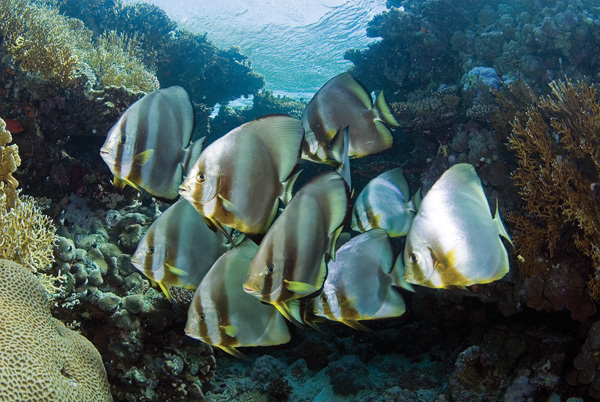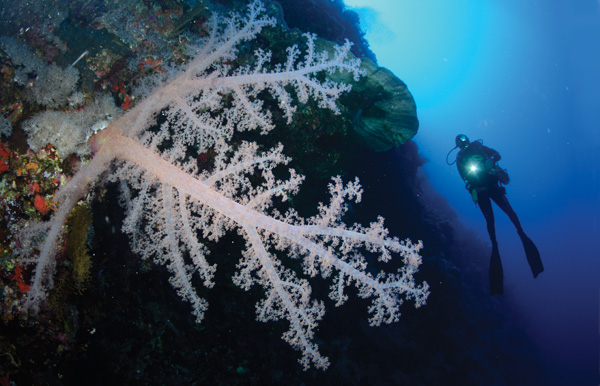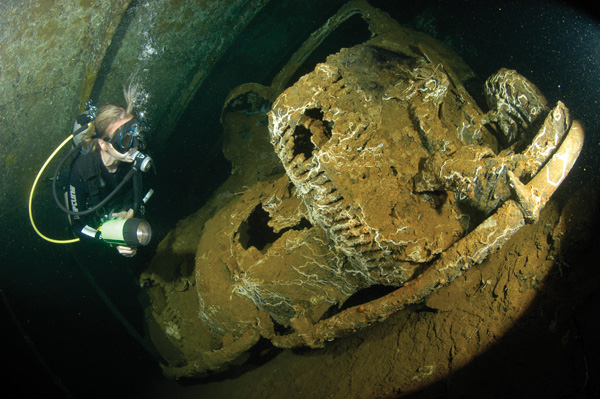SCUBA destinations guide
Whether you’re thinking about a bargain club outing or a once in a lifetime holiday, SCUBA has assembled the best of the world's diving destinations.
All photos ©Simon Rogerson.
Bonaire - Dive and drive
Just 50 miles above Venezuela, Bonaire is one of the Netherlands Antilles, a strange hybrid of Caribbean, Dutch and American cultures. For divers, it’s one of the few places in the Caribbean where guides are happy to leave you alone to do your own thing. Almost all the diving is accessed by shore – currents are negligible and the entry points are simple. You hire a car, load up your cylinders and dive kit, then drive around the island to signposted entry points. The reefs are sedate, but very pretty, with plenty of vase sponges, though there are a few wrecks, including the infamous Hilma Hooker, which went down with 1,200kg of marijuana in the hold. The standout dive, however, is the Town Pier, which proves a habitat for seahorses and juvenile fish.
St Lucia - Lovers rock
Certainly one of the most romantic destinations, St Lucia has a strong diving tradition and a good selection of sites on the Caribbean side of the island. The resorts are a little pricey, but quality is high and some of the settings will take your breath away – many of the hotels in the Soufriére area have views of the spectacular, conical Piton Mountains. If you stay at Jalousie Plantation Resort, you’ll be right between them, and with an excellent house reef as a bonus.The dives are mostly gentle drifts over sponge dominated reefs, but there are a few good wreck dives, including the beautiful Lesleen M, bedecked with gorgonian fan corals.
Dominica - Natural wonders
With its verdant mountains and lack of development, Dominica is a taste of the old Caribbean. There are no chain hotels and the little airport can only support the modest air craft used for island-hoppers. The best diving is found around Scott’s Head Peninsula on the southern side of the island, where you’ll find beautiful sponge and coral reefs, and caverns billowing with black bar soldier fish. The reefs are critter-rich, so you can expect to see frogfish, seahorses and the frankly hideous shortnose bat fish, alongside more common reef creatures. As with other Caribbean destinations, mid-water fish life is sparse, but Dominica is better than most. There are a few wrecks, but they are not especially interesting.
Vancouver Island, Canada - Play it cool
Arguably home to the best cool water diving in the world, Vancouver is a large island off Canada’s north west coast. Elements of its underwater scene will be familiar to UK divers – there are plumose anemones and alcyonium soft corals similar to the ones you find off UK shores. But the invertebrate life in Canada grows to greater sizes, a consequence of super-rich Pacific water. Browning Pass is the signature site – you can expect to see friendly wolf eels (much bigger than the ones you find in the UK – up to 2m long), giant Pacific octopus and plenty of fish. Shark aficionados can try to find the elusive six gill bluntnose shark at Hornby Island. There’s plenty to keep wreck divers occupied as well, with artificial reefs such as the 140m-long Cape Breton Victory Ship, or the historical wrecks of Barkley Sound,the ‘Graveyard of the Pacific’.
Guadalupe, Mexico -Great white mischief
If you want to see the biggest predatory fish in the world, head down Mexico way. Guadalupe (don’t mistake it with the Caribbean island of the same name) lies in the route of a tuna migration, which makes it a very attractive proposition for hungry great whites. The water is very blue, and clearer than rival shark spots around Capetown. The liveaboards that visit Guadalupe mostly depart from Ensenada in Mexico, but you fly in to San Diego in USA and cross the border by coach. These boats have spacious, purpose built shark cages with air supplied direct from a compressor, so there’s no need to wear a cylinder.
Florida, USA - More driving, more diving
Head south from Miami to the Florida Keys, and you’ll find easy-going reef diving and some wonderful wrecks, including the USCG Cutter Duane, sunk as an artificial reef in 1987 and today home to myriad forms of encrusting sponges, crustaceans and fish. The Gulf coast of Florida isn’t well known for its diving, but at Pensacola you can dive the immense aircraft carrier USS Oriskany, which has a depth range between 20m and 65m. At Crystal River on the west coast, you can snorkel with manatees, while at Palm Beach on the Atlantic coast there are more wrecks, sharks and Goliath grouper. Blue Heron Bridge in West Palm Beach has the best macro diving in the continental USA – you can find Atlantic mimic octopus, seahorses and bumblebee shrimp on a single dive. Florida has great all-round diving, but you have to cover a lot of ground to experience its diversity.
Komodo, Indonesia -The dragon’s lair
Komodo is a liveaboard-only destination with departures from the island of Bali. Diving takes place either on blue-water reefs, limited visibility lagoons or sandy slopes – there are no wrecks. This itinerary is regarded as one of the classic Indonesia tours, and takes in some beautiful islands along the way, including Komodo and Rinca, both home to the giant monitor lizards known as Komodo dragons. Along the north of these islands, the water is very clear and you get classic Indo-Pacific reef scenery. By contrast, the south sides are affected by cold-water upwellings and support different life forms, such as the sea apple and the toxic urchin, which provides a home for commensal shrimp. Komodo also has a cleaning station for manta rays.
California, USA - Help from the kelp
Don’t think of California as a place with easy diving and warm water. Los Angeles and San Diego may have a subtropical climate, but the ocean is swept with coldwater currents. The highest water temperature is 20°C in August, falling to 13°C in February. It’s warmer than the UK, but still essentially a drysuit destination. The place to go is the Channel Islands, offshore from Los Angeles. The temperate waters here are home to a spectacular ecosystem, the giant kelp forest, which rises from 30m to the surface. Around the kelp you will find bright orange garibaldi fish, tope sharks, angel sharks and opalescent squid. You can base yourself on land at Santa Catalina, or join a liveaboard trip around islands such as Santa Barbara, known for its population of feisty California sealions.
Philippines - The all-rounder
For divers, a visit to the Philippines usually means heading to the central islands, known as the Visayas. The hub is Cebu, known for its diverse reefs and critter dives. Fishing has taken a toll on some of the bigger fish species, but there’s still plenty to see, including the famous baitfish shoal at Pescador Island. For dramatic walls, go to Cabilao Island off Bohol, a picture-perfect desert island with sheer walls dominated by golden fan corals. Some of the best diving can be found around Malapascua Island, which has a Brit-owned dive centre and access to the Monad Shoals, where you can see thresher sharks on early morning dives. Closer to Manila, there is the sprawling resort hub of Puerto Galera, which offers good allround diving and a few purpose-sunk wrecks.
Rajah Ampat, Indonesia - The hot zone
Rajah Ampat is currently the most fashionable destination in coral reef diving. Why? It is beautiful above and below the water, it is very remote (and therefore exclusive) and the seas here have the highest recorded biodiversity on the planet. This remote archipelago lies off the northeast coast of West Papua, Indonesia’s most easterly province. It is composed of 1,500 limestone islets and is home to 1,000 fish species, 537 coral species and 699 mollusc species. Underwater, you will see everything – from wobbegong sharks to tiny blue-ringed octopus. There are plenty of different environments, from classic coral reefs to blue-water mangrove systems where soft coral grows just inches under the surface. There are manta ray cleaning stations, schools of bumphead parrotfish, three different types of pygmy seahorse and much more. Liveaboards are popular, but a few eco-resorts have sprung up and are proving popular.
Papua New Guinea - Coral Eden
An old school destination, but still one of the very best. Papua New Guinea (PNG) has everything – superb coral scenery, wrecks from the Second World War and a good chance of pelagic encounters. It’s a long schlep to the capital, Port Moresby (most flights from the UK are routed via Manila or Singapore), but there is great diving close to the airport, at Loloata Island Resort. Otherwise, you need internal flights to take you to the other prime diving locations – Kavieng, Walindi Plantation, Tufi and Tawili. These locations are exclusive and remote, to the extent that you are pretty much guaranteed to be the only dive boat on a site. For adventurers, liveaboards will venture to far-off sites such as the Eastern Fields in the Coral Sea, or the Fathers Reefs in Kimbe Bay. PNG is the original home of critter diving, so there really is something for everyone, but the flight and other costs make it a very expensive destination.
Thailand - Spice up your dives
It’s a game of two halves in Thailand. On the east side of the country there are party islands in the Gulf (Koh Samui, Koh Tao and others) where you can enjoy some reasonably entertaining diving. Off the Indian Ocean coast to the west there is a lot more to see, especially at the Similan and Surin islands. The Similans, 50 miles northwest of the holiday island of Phuket, have some very pretty coral reefs, but there has been storm and El Nino damage in this area. Further north, close to the Burmese border, Richelieu Rock is a magnet for pelagic fish, including whale sharks. Another highlight of this area is Koh Tachai in the Surin Islands, where you can dive with cuttlefish and schools of batfish. In general, Thailand is a fish-spotter’s destination with some beautiful islands and a good chance of pelagic encounters. Oh, and the best liveaboard food in the world, as long as you can handle a bit of spice.
Great Barrier Reef, Australia - G’day, sunshine
Most visiting divers either choose a trip to the Ribbon Reefs out of Cairns, or the remote Coral Sea beyond the reef. You can pick up the liveaboard in Cairns and cruise your way out to Lizard Island before catching a flight back in a small aircraft, or fly straight to Lizard and work your way back to the mainland. The highlight of the voyage is Cod Hole, famous for the semi-tame potato cod and Queensland grouper that gather to be fed by dive guides. Otherwise, the reefs are pretty rather than spectacular. In June and July, there’s a good chance of swimming with dwarf minke whales on this route. The Great Barrier Reef has a few wrecks, but the only really good one is the Yongala, and you’re not allowed to enter it.
Maldives - Fish soup
Generally seen as a step up from the Red Sea in terms of price and exclusivity, the Maldives are recommended for fish lovers. The hard coral in the shallows can be patchy, but the soft coral growing in caverns and overhangs is spectacular. There is a smattering of historical and purpose-sunk wrecks, but the real draw here is diving in the atoll passes, where schooling fish and predators revel in the current. If you want to see the famous resident manta rays, February to April is a great time to go. Diving purists should book a liveaboard, honeymooners should book an island resort. The islands of the Maldives are split into atolls, each of which has its own peculiar magic. For spectacular channel diving, it’s hard to beat South Ari Atoll, where schools of blue-lined snapper swarm across the reef while whale sharks pass by overhead (sometimes). Recently, there’s been a lot of fuss about the manta ray aggregation at Hanifaru, but there are cleaning stations all over the archipelago where you can see multiple mantas, and Hanifaru is now subject to restrictions.
Balearic Islands, Spain - The family option
An affordable option for club trips and family holidays, the Balearic Islands lie in the Mediterranean and offer a surprisingly diverse array of diving. Briefly, the island of Menorca is known for its caverns and ancient wreck sites; Mallorca is known for its easy diving and colourful fan corals; Ibiza has a great wreck, the Don Pedro ferry; the little island of Formentera is noted for its protected species, including seahorses and pipefish. During the summer, all these islands have clear, blue water and mostly calm conditions, though we wouldn’t recommend them as winter destinations. You don’t really get a lot of big fish in this part of the Mediterranean, but the reefs are pretty and the water is clear. Menorca is a good place to get to grips with basic cave diving techniques.
Canary Islands - Bargain hunt
One of the best value destinations around, the Canaries offer affordable diving year-round. All the islands have wrecks and reefs, but there are subtle differences. Gran Canaria is probably best for wrecks, with its busy shipping lanes and international harbour. Tenerife has some interesting scenic dives and Lanzarote is good for fish spotting, especially stingrays and angel sharks. There’s not a great variety of schooling fish, but you do get some impressive schools of bream, grunts and barracuda. The best diving used to be at the island of El Hierro, but recent months have seen volcanic activity off its coast and a cloud of debris from the underwater volcano has destroyed the once amazing fish life. No one knows quite what this volcano is going to do next – will it continue erupting and break the surface? Whatever happens next, El Hierro is the most south westerly of the islands, and with prevailing winds coming from the north east, the volcanic residue will be blown away from the other islands and towards the equator.
Malta and Gozo - Singing the blues
Malta and her islands have the most perfect, cobalt blue water in the Med. In summer, the visibility is a reliable 30m and divers can make the most of the spectacular geological formations for which the islands are famous – blue holes, cathedral-like caverns and hidden lagoons. In terms of life, it’s a long way from the fish soup of the Indian Ocean or the central Pacific. However one thing Malta has is wrecks. From the spectacular Blenheim Bomber to the stately Um el Faroud, there’s a wreck to suit every level of skill and experience. Although many dives in Malta and Gozo take place from the shore, increasing numbers of technical divers are visiting to visit wrecks in the 70-80m range, including the British submarine HMS stubborn and Le Polynesien, an armed liner. This destination has become a home from home for many British divers, who love the climate and welcoming locals.
Gibraltar - A rock and a nice place
‘Gib’, as aficionados like to call it, is one of the world’s underrated scuba destinations, combining elements of the Mediterranean and the Atlantic. This British overseas territory offers a mixture of scenic, wreck and critter diving. In terms of marine life, you will see octopus, moray eels, fantails and plenty of local fish. For a relatively small area, it has a wealth of sites, including the photogenic Seven Sisters and the spectacular Europa Point at the very tip of the territory, known for its pinnacles and walls. Wreck divers are spoiled for choice – the signature wreck is probably the SS Rosslyn, which lies at the bottom of the sloping breakwater at 24m. During the summer the surrounding sea is thick with migrating cetaceans, including pods of pilot whales.
South of France - Oh la la!
The South of France is the spiritual home of scuba diving – it was here that Jacques Cousteau first stepped into the water and tried out the prototype aqualung. Unfortunately, the first generations of divers were a bit trigger-happy with their spearguns, so the few remaining big fish in this part of the world live in fear of divers. Nevertheless, there is still a beautiful ecosystem, with yellow and red gorgonian corals in the deeper sections below the algae strangled shallows. For UK divers, the South of France is really a wreck diving destination, with some great wrecks dating from the Second World War. The best of these is probably the Saphir-class submarine, Rubis, which served in the French Navy and was sunk in 1958 off the coast of St Tropez for sonar experiments. Sitting perfectly upright at 41m, it is one of the best wrecks in the Med.
Sardinia - Pure class
Sardinia has some of the best all round diving in the Mediterranean. It’s certainly one of the most picturesque islands, lying to the south of Corsica where it is bathed in turquoise water. Underwater there are caverns, wrecks and reefs sparkling with yellow corals. Around the region of Capo Galera, you can dive on the debris fields of ancient Roman wrecks and Spanish galleons. To the north between Sardinia and Corsica there is the marine reserve of Lavezzi, an area of scattered pink rocks in the Bonifacio Strait. This is probably the best place in the Med to dive with the endemic species of grouper, known locally as ‘meru’. They may not be as big as the giant grouper of the Indo Pacific, but they are still thumping great fish, and thanks to the protection of the reserve, they are not shy of divers. Sardinia has a selection of Second World War wrecks, including SS Isonzo and SS Romagna in the south of the island, and the KT-12 armed transport ship, south of Orosei.
Cyprus (south) - Zen diving
People dive in Cyprus year-round, but the best conditions are during the summer when the sea is flat and warm. The big draw is the wreck of the ferry Zenobia, which is big enough to keep a group of wreckies occupied for a week or more. There are more wrecks to the west around the resort centre of Paphos, including the Achilles, which lies at 11m, and the Vera K, a Turkish cargo ship. The reefs are dominated by tall seagrass meadows and rocky patches haunted by octopus. Cyprus is also known for its topography, including some pretty caverns. In general, the diving is easy and straightforward, though in the case of the Zenobia it can be as challenging as you choose to make it. The shallowest parts of the wreck are suitable for Ocean Divers, while the deepest recesses demand planning and experience. An ideal setting for a club trip or a family holiday, Cyprus is a perennial divers’ favourite.
Sinai, Egypt - The old friend
For UK-based divers, the Sinai Peninsula offers coral reef diving at an amazing price. The main hub is Sharm el Sheikh, the town that diving (and Hosni Mubarak) built. Base yourself here to dive the marine park at Ras Mohammed, still one of the world’s greatest dive sites with its schooling fish and vibrant coral. From Sharm, you can also dive at the Straits of Tiran to the north, and the famous wreck of the Thistlegorm to the south. North of Sharm there is laid back Dahab, home to the famous Blue Hole and popular with everyone from snorkellers to tekkies. Keep heading north and you get to Nuweiba, also noted for easy shore dives and very popular with photographers. Finally, close to the border with Israel, there is Taba, a sedate resort enclave serviced by its own little airport. Again, it’s mostly shore diving, with an emphasis on critters such as frogfish.
Southern Egypt - Desert delights
Loosely defined as the area south of Marsa Alam, Egypt’s ‘Deep South’ is no longer a blank spot on the map and is now seen as an upmarket answer to the fleshpots of Sharm and Hurghada. New resorts have sprung up around the development at Port Ghaleb, creating new opportunities to explore this once isolated zone. There are some healthy hard coral reefs in the Fury Shoal, while further south there is St John’s Reef, known for its ‘habili’ coral bommies. The offshore diving can be spectacular, and if your liveaboard tour encompasses the Brother Islands to the north you will have a world-class array of diving to enjoy. Closer to land, the reefs are not quite as spectacular, but with dolphins, oceanic white-tip sharks and even dugongs all in the mix, there’s plenty to see. Even if you don’t get to see the big stuff, there’s a decent smattering of wrecks dating from the 19th Century to the current era. Crowding can still be a problem at some sites, but it’s nowhere near as bad as the Sinai.
Sudan - Far from the crowds
Sudan is a trip for diving purists who have seen everything Egypt has to offer and are looking for a different Red Sea. The nation itself is stark and unwelcoming, but the dive sites are awe inspiring. The reefs at Sanganeb and Sha’ab Rumi represent the Red Sea at its very best, a bustling ecosystem complete with grey reef sharks, schooling barracuda and hammerheads. The soft coral at Sanganeb is as vivid and lush as anything you will find at Fiji, supposedly the soft coral capital of the world. There are some world-class wrecks, including the cargo ship Blue Belt and the famous Umbria, scuttled by its Italian crew outside Port Sudan in the days leading up to the Second World War. The most memorable dives are on the wreckage of Jacques Cousteau’s underwater habitat project, Conshelf II, at Sha’ab Rumi.
Jordan - By royal decree…
Jordan is more expensive than the Egyptian Red Sea and only has about 15 miles of coast – so why visit? In the first instance, the sites are less crowded as there are fewer visitors. Secondly, the dives are very rewarding. The Cedar Pride shipwreck may have been purpose-sunk on the orders of the King Abdullah, but having been on the seabed since 1985, it is now coming into its own as an artificial reef, and is festooned with coral. Jordan has incredible diversity along its small coastline – you can search for octopus and other critters during night dives, enjoy steep walls plunging into the depths and even visit the wreck of an American M40 anti-aircraft tank. Deep divers have the wreck of the Taiyong, with a maximum depth of 60m.

